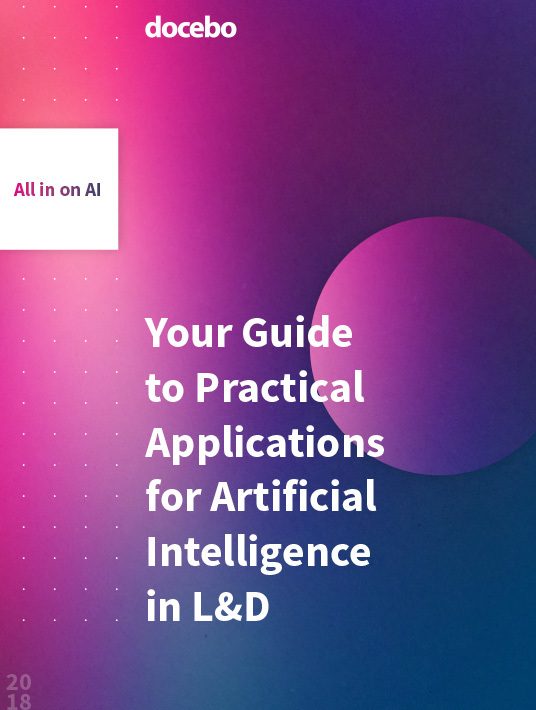AI Transforms Learning Into A Competitive Advantage
Data has long been coined the new oil, but data on its own won’t power your organization’s learning engine. It’s now critical to transform the data collected by your platform on your learners’ activities into actionable insights. These are used to create unique experiences with Artificial Intelligence (AI) in Learning and Development.

What is unique about AI in the context of Learning and Development? It is built on learning-specific algorithms, powered by a fine-tuned combination of machine learning, deep learning, and natural language processing.
Machine learning is a system where a computer learns without being explicitly programmed. For example, in machine learning capacities, a computer program is trained to recognize patterns, such as identifying someone’s face. It can also learn to complete an action, like responding to a request for information. Training the system to do that requires exposure to many different variables.
In deep learning, interconnected layers of software-based calculators—“neurons”—form a neural network. That network ingests vast amounts of input data and processes it through multiple layers. These layers learn increasingly complex features of the data in each layer. The network can then make a determination about the data. It can then understand if its determination is correct, and then use what it has learned to make determinations about new data.
Natural language programming is the ability of machines to understand and interpret human language. Its objective is to make computers/machines as intelligent as humans in understanding language. The ultimate goal is to close the gap between how humans communicate (natural language) and what the computer understands (machine language).
AI Automates Learning And Development
These specialized algorithms enable your learning platform to automatically perform some of the actions that you would do manually, either as a learner or admin. For example, your learning platform can now safely and securely analyze nearly all of the different types of content that you’re adding to your platform. Not only that, but it can also find ways to enhance and simplify the learning experience.
Learners can use the platform’s global search to find the most relevant content for them without the need for an admin to manually tag the content. Additionally, learners can invite other learners to view their uploaded content based on their content history. The best part is it all happens behind the scenes, without ever interrupting the learning experience.
Explore Limitless Possibilities
A survey of 3,000 business leaders by Boston Consulting Group and MIT Sloan Management Review had some interesting results. It found that many executives understand AI’s potential, but have yet to put a strategy that leverages it into action.
Here are some of the most interesting findings from the survey:
- 75% of executives believe AI will enable their companies to move into new businesses.
- Almost 85% believe AI will allow their companies to obtain or sustain a competitive advantage.
- Over 60% of all companies don’t have an AI strategy in place.
AI exposes endless possibilities for Learning and Development, and in incredibly positive ways (contrary to what Hollywood might suggest):
- Think: smart automation of various admin tasks, plus the complete personalization of learning.
- AI is dependent almost entirely on algorithms humans create.
- AI performs tasks that would normally require human intelligence, such as visual perception, speech recognition, decision-making, and translations.
L&D Has Evolved To Reflect The Expectations Of The Modern Learner
Adapting to the needs and expectations of today’s learners means:
- Having a wider acceptance of learning technology
- Having a deeper understanding of the importance of Instructional Design
- Recognizing that organizations must invest in the professional development of their workforces because that’s what their learners expect
- Recognizing the actual outcomes of learning, as it’s an effective way of connecting learning to organizational performance, and therefore revenue
AI is heading in the direction that Learning and Development moved toward when they recognized the need for a wider acceptance of technology.
They also strive to:
- Develop a deeper understanding of the importance of Instructional Design
- Invest in professional development
- Place a renewed focus on learning outcomes
- Make actual use of simulation and gaming in learning activities
AI In L&D Is Much More Than A Content Suggestion Engine
When most people are asked to consider how AI impacts our everyday lives, their go-to response is the "suggestion engines" that power the content recommendations you see each time you log into Netflix or Amazon. Indeed, AI is the backbone of these suggestion engines, and in the context of eLearning, it would be easy to pigeonhole a learning platform’s AI functionalities to just that: a suggestion engine. AI-powered learning is much more than that.
By making AI the engine upon which the whole learning platform lies, L&D has the opportunity to open up new capabilities for admins to develop more immersive and personalized learning experiences, while automating menial tasks. For learners, AI drives the three E’s that are key to achieving better learning experiences: expedience, efficiency, and effortlessness. The effectiveness of AI depends on how much people actually use the system; the more data the system processes, the more AI learns about individual learner needs, turning the learning platform into a continuous improvement engine that grows alongside your learners
Machine Learning Is To Artificial Intelligence What Books Are To Learning
Artificial Intelligence is the theory and development of computer systems that are able to perform tasks that normally require human intelligence, such as visual perception, speech recognition, decision-making, and translation between languages. In the context of enterprise learning, AI has the incredible potential to amplify technology to make data-driven analyses and decisions (faster), emphasize areas of improvement for individual learners, and create immersive learning experiences—not just lessons.
Machine learning is the study of systems where a computer learns without the need for further programming. For example, in machine learning capacities, a computer program learns to recognize patterns or complete an action, such as identifying someone’s face or responding to a request for information. Training the system requires it to be exposed to as many variables for completing a task as possible, using different types of input data.
Taking AI In Learning And Development To The Next Level
Learning and Development benefits a lot from AI implementation. There are numerous things that the implementation of Artificial Intelligence can achieve. If you would like to know more about it, download our eBook All In On AI: Your Guide To Artificial Intelligence In L&D and learn how AI sets new standards in Learning and Development.









